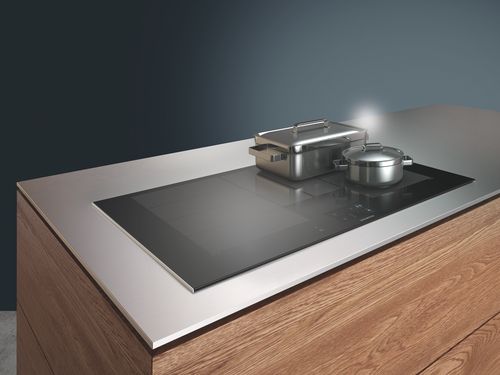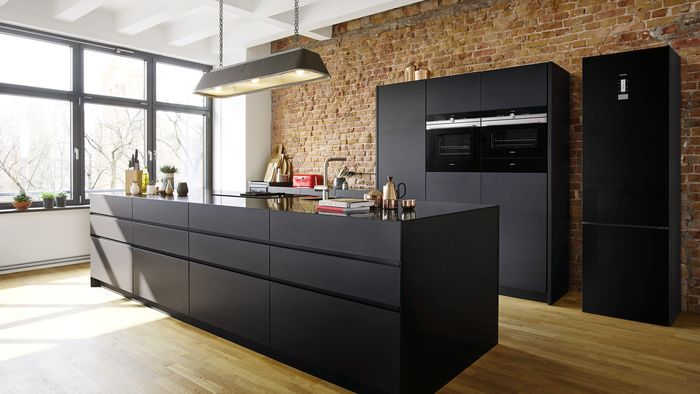Questions and answers for cooking with induction.
- Which advantages does cooking with induction offer?
- How does an induction cooktop work?
- Which cookware should I use?
- How does cookware interact with the cooktop?
- How to check the induction suitability of cookware?
- Why can I hear noises and what does that mean?
- Does an induction cooktop influence your health?
- How to avoid glass damages?
- How to activate/deactivate the childproof lock function?
- Cooktop displays shows E:0513. What does this error code mean?
- How to uninstall the cooktop?
Which advantages does cooking with induction offer?
Induction cooking is very different from traditional cooking methods, as heat builds up directly in the item of cookware. This offers numerous advantages:
- Saves time when boiling and frying.
- Saves energy.
- Easier to care for and clean. Spilled food does not burn on as quickly.
- Heat control and safety – the hob increases or decreases the heat supply as soon as the user changes the setting. The induction hotplate stops the heat supply as soon as the cookware is removed from the hotplate, without having to switch it off first.
How does an induction cooktop work?
There are induction coils made of wire located beneath the ceramic glass. If electric current is supplied to a cooking zone or area by switching it on, the coil creates a magnetic field that acts directly on the bottom of the pan and heats it. But for the induction to work, cookware with a magnetizable bottom is required. The surface of the ceramic glass is heated only by the heat given off by the cookware. This makes induction quick to use, safe and convenient. It is activated only when the proper cookware is placed on it.
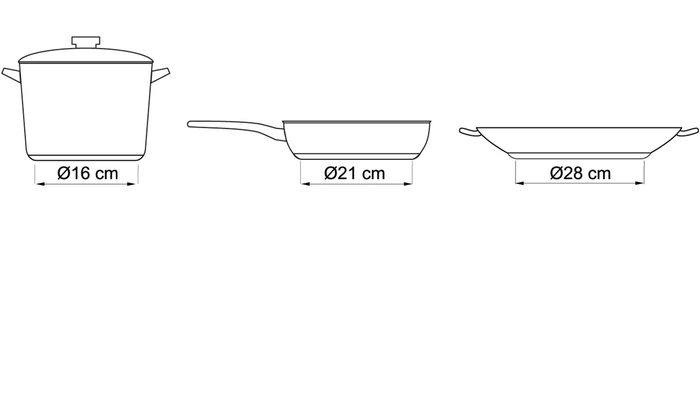
Which cookware should I use?
Only use ferromagnetic cookware for induction cooking, such as:
- Cookware made from enamelled steel
- Cookware made from cast iron
- Special induction-compatible cookware made from stainless steel.
To check whether your cookware is suitable for induction cooking, refer to the appropriate section in the user manual .
To achieve a good cooking result, the ferromagnetic area on the base of the pan should match the size of the hotplate. If a hotplate does not detect an item of cookware, try placing it on another hotplate with a smaller diameter.
Recommended Products
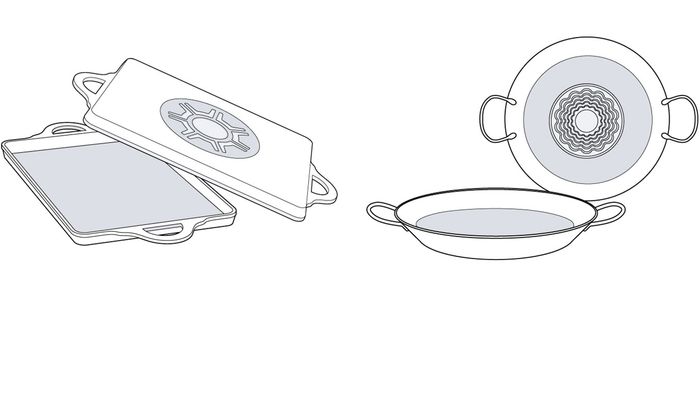
Some induction cookware does not have a fully ferromagnetic base:
- If the base of the cookware is only partially ferromagnetic, only the area that is ferromagnetic will heat up. This may mean that heat will not be distributed evenly. The non-ferromagnetic area may not heat up to a sufficient temperature for cooking. For this reason, we recommend to use cookware with the whole base manufactured in ferromagnetic material.
- The ferromagnetic area will also be reduced if the material from which the base of the cookware is made contains aluminium, for example. This may mean that the cookware will not become sufficiently hot or even that it will not be detected.
Never use diffuser hobs or pans made from:
- common thin steel
- glass
- earthenware
- copper
- aluminium
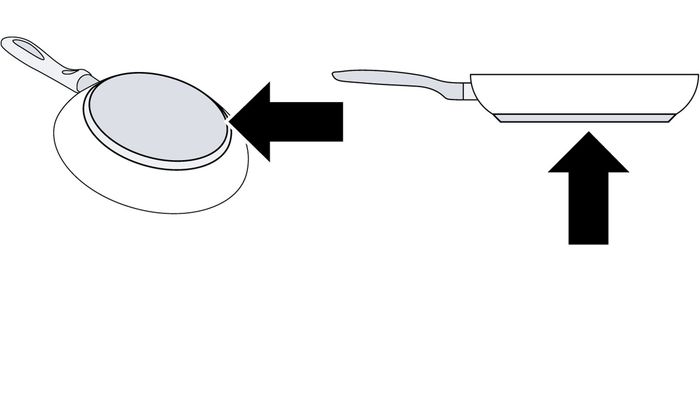
Properties of the base of the cookware:
The material(s) from which the base of the cookware is made can affect the cooking result. Using pots and pans made from materials that distribute heat evenly through them, such as stainless-steel pans with a three-layer base, saves time and energy.
Use cookware with a flat base; if the base of the cookware is uneven, this may impair the heat supply.
How does cookware interact with the cooktop?
Absence of pot/pan or unsuitable size
If no pan is placed on the selected hotplate, or if it is made of unsuitable material or is not the correct size, the power level displayed on the hotplate indicator will flash. Place a suitable pan on the hotplate to stop the flashing. If this takes more than 90 seconds, the hotplate will switch off automatically.
Empty pot/pans or those with a thin base
Do not heat empty pans, nor use pans with a thin base. The hob is equipped with an internal safety system. However, an empty pan may heat up so quickly that the "automatic switch off" function may not have time to react and the pan may reach very high temperatures. The base of the pan could melt and damage the glass on the hob. In this case, do not touch the pan and switch the hotplate off. If it fails to work after it has cooled down, please contact the Siemens Home Appliances Service .
Pot/Pan detection
Each hotplate has a lower limit for pan detection. This depends on the diameter of the ferromagnetic area of the cookware and the material from which its base is made. For this reason, you should always use the hotplate that best matches the diameter of the base of the pan.
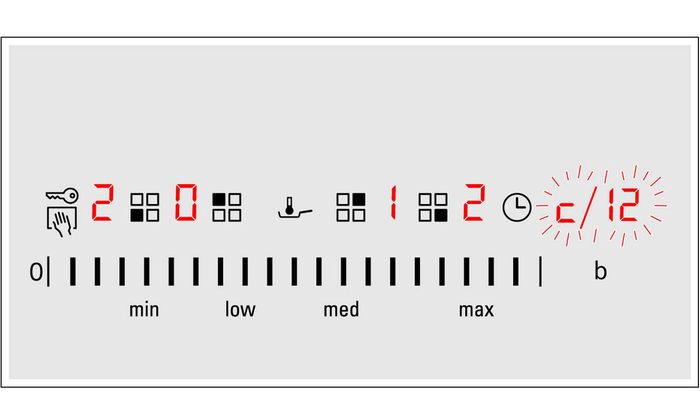
How to check the induction suitability of cookware?
The quality of cookware has a big impact on the speed and quality of a cooking process. This function allows you to test the suitability of your cookware (only available for induction hobs IH6.2).
1. Place a cold saucepan containing approx. 200 ml of water in the center of the hotplate the diameter of which matches the base of the pan most closely.
2. Go to the basic settings and select the c12 setting.
3. Touch the control panel. Symbol – will flash on the hotplate display. The function has now been enabled.
After 20 seconds, the quality and speed of the cooking process will appear in the hotplate display.
| Result | |
| 0 | The cookware is not suitable for the hotplate and will therefore not heat up.* |
| 1 | The cookware is taking longer to heat up than expected and the cooking process is not going as well as it should.* |
| 2 | The cookware is heating up correctly and the cooking process is going well. |
- If the diameter of the hotplate used is much smaller than the diameter of the cookware, only the middle of the cookware can be expected to heat up. This may result in the cooking results not being as good as expected or being less satisfactory.
- You can find information on the type, size and positioning of the cookware refer to the appropriate section in the user manual .
Why can I hear noises and what does that mean?
Why I can hear noises while I'm cooking?
Noises may be generated while using the hob depending on the characteristics of the base of the cookware. These noises are a normal part of induction technology. They do not indicate a defect.
Possible noises:
- A low humming noise like the one a transformer makes: Occurs when cooking at a high heat setting. The noise disappears or becomes quieter when the heat setting is reduced.
- Low whistling noise: Occurs when the cookware is empty. The noise disappears when water or food is added to the cookware.
- Crackling: Occurs when using cookware made from layers of different material or when using cookware of different sizes and different materials at the same time. The volume of the noise may vary depending on the quantity of food being cooked and the cooking method.
- High-pitched whistling noises: May occur if two hotplates are used at the highest heat setting at the same time. The whistling noises disappear or become quieter when the heat setting is reduced.
- Fan noise: The hob is equipped with an internal refrigeration fan that automatically switches on when temperature rises. The fan may continue to run even after you have switched off the hob if the temperature detected is still too high.
- Rhythmical tones like the ticking of a clock: This noise only occurs when three or more hotplates are on. The noise disappears or becomes quieter when one of the hotplates is switched off.
Does an induction cooktop influence your health?
Do electromagnetic fields occur when an induction cooktop is used, and if so, are they a health hazard?
Electric and magnetic fields are always present whenever devices are used that are operated by electric current - including hair dryers, electric shavers, vacuum cleaners, washing machines and induction cooktops.
There are internationally recognized limits and standards that must be adhered to in principle by all manufacturers. Our equipment is tested regularly and meets the legal requirements without exception. Therefore, when used properly - as described in the instructions for use - the induction cooktops offered by our company are safe and are substantially below the EU limits.
What recommendations are there for wearers of pacemakers, defibrillators or other active implanted medical devices?
If you have an active, implanted medical device (such as a pacemaker or defibrillator), please ask your doctor to confirm that it complies with Council Directive 90/385/EEC of the European Community dated June 20, 1990, as well as DIN EN 45502-2-1 and DIN EN 45502-2-2, and was selected, implanted and programmed in accordance with VDE-AR-E 2750-10. The use of an induction cooktop – in accordance with its intended purpose and the instructions of the user manual – is safe if these prerequisites are met and non-metallic cooking utensils and cookware with non-metallic handles are used.
How to avoid glass damages?
Ceramic Glass is very hard, but fragile. Impacts of falling objects can break the glass. Try to avoid to place objects prone to fall down located above the hob. Edges of the glass are more sensible. Avoid specially impacts with pots, lids, etc in these areas. A hob with broken glass can create risk of cut injuries and even risk of electric shock. Do not continue using a hob with a broken glass. In order to repair it, please call Customer Service . In order to maintain the surface quality and avoid damages, please take into account the recommendations in the user manual .
How to activate/deactivate the childproof lock function?
The appliance has a "Childproof lock function" to avoid the activation of the hob by small children. This function is displayed with an specific symbol in the user manual .
If you want deactivate it:
1. Switch on the hob using the main switch.
2. Touch and hold the corresponding displayed symbol for approx. 4 seconds.
The lock is released.
Cooktop displays shows E:0513. What does this error code mean?
If E0513 appears on the appliance's display at the first usage, the appliance is probably not connected correctly to the electric power supply of the household.
Switch the appliance off from the power supply and contact your installer to check the power cord wiring connection.
How to uninstall the cooktop?
Uninstallation can start only after switching the appliance completely off from the mains. Use gloves to uninstall the appliance.
Risk of electrical shock! When disconnecting the cooktop from the mains, the terminals - power cord could remain electrified because internal electronic components can be still charged. After removal of all possible fixation elements, push carefully the hob upwards from below to remove it. Electrical installation is only allowed by an authorized specialist technician.
Caution! Damage to the appliance! Do not try to remove the appliance by prying / levering it out from above at the sides of the glass-frame.

